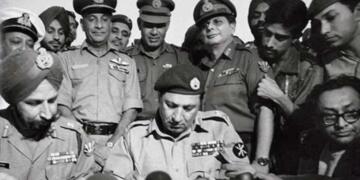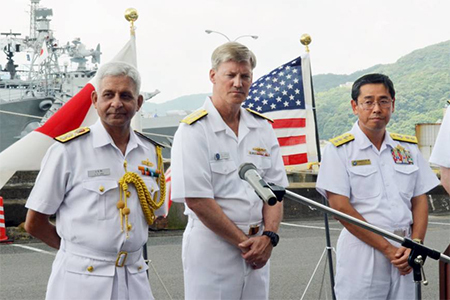Military build up is all about showing the might to the world. So when a missile is launched or a nuclear device exploded, it’s all about grand standing your military might and arsenal in an individualistic capacity. But joint exercises have more potent effect because the military might of many allied countries combine to relay a certain message in geopolitical scheme of things. Perhaps the nation not invited or participating in the joint operation is surely bound to feel the exercise is meant to send a signal. And this is exactly what a Malabar expedition is expected to do.
Malabar series began in 1992 as a naval exercise between India and the United States . It basically was pertaining to diverse activities and maritime operations. Three such studies were conducted before it was suspended owing to India’s entry into the nuclear league. Following 9/11, Malabar series again resumed with the pretext of war on terrorism and the changed geo political equations. The joint exercises may have assumed a bilateral venture. However over the years, the entry of Japan in this collaboration in 2015 has certainly given it a strategic outlook. Although United States has denied it, the overall scenario seemed like a ‘Chinese containment policy’. All the three powers have denied and the exercises have been touted as a tripartite co operation between the navies of the three countries in lieu with maritime operations. Nevertheless, efforts have also being made to bring Australia in to the fold which definitely has raised a lot of geopolitical eyebrows. The expedition comprised of aircraft carriers, submarines and maritime patrolling air craft in wide range of combat missions and mimicking sea war fares.
This year the Malabar exercise is going to begin in the Bay of Bengal on July 10 and is supposed to be the largest of them all.
The range of MALABAR in 2017 includes activities during the Harbour Phase at Chennai from 10 to 13 July 2017 and an assorted range of operations at sea during the Sea Phase from 14 to 17 July 17. This time around, the exercises are coinciding with three aspects in line with the three countries participating in the same.
India is locked in a major tussle with the Chinese in Sikkim where the Chinese have accused India of making incursions. This comes as fallout of Chinese making incursions at regular intervals in the Indian Territory which has made New Delhi quite wary of Beijing.
The second aspect is the election of Trump as the US President which has seen him making a lot of anti Chinese comments during run up to the elections. This will more fuel in the postulated Chinese containment policy.
The third aspect is about the arch rivals Japanese who always had an acrimonious relationship with the Chinese and the South China Sea dispute.
There is also another fourth angle of a resurgent and aggressive North Korea and pressure is on China from the international community to make them hold their horses.
Although the participants have denied this exercise has anything to do with the Chinese, there is so much to worry for the Asian giant. Firstly, its the nature of operations underlying the oceanic event. The exercises at sea this year would be propelled on Aircraft Carrier operations, Air Defence, Anti-Submarine Warfare (ASW), Surface Warfare, Visit Board Search and Seizure (VBSS), Search and Rescue, Joint Manoeuvres and Tactical procedures. Looking at the operational landscape of the exercises, its clear for what they are designed.
According to a Chinese online portal ‘Pengpai’, the presence of the U.S. built P-8 planes and the proposed induction of MQ-9B drones in the Indian arsenal is indicated to chip in for Malabar. This inclusion according to it was evidence of a converging military partnership between them.
“The P-8 is considered the most advanced in the world. India has bought eight of them and in the future it will buy another eight. It will fully replace the old Soviet era ASW aircraft such as the IL-38 and TU-142,” observes the online portal.
Secondly, the exercises will include India’s aircraft carrier, Japan’s largest warship Izumo and a Nimtz series nuclear propelled American warship.
In addition, 16 ships, 95 aircraft comprising a fleet of fighter jets, and two submarines will take part in the war games. This show of strength is a warning to aggressive misadventures of the Chinese in the South China Sea. It also will create a trilateral ‘Strategic big brother’ protecting countries such as Cambodia, Vietnam and Philippines in the region from Chinese aggression.
The joint exercises according to Eastern Naval Command, Vice Admiral H C S Bisht is a joint attempt to address common challenges and address shared threats. China was trying to exert its influence in the South China dispute. It also made attempts to encircle India with pro Chinese puppets and install a colonial China Pakistan Economic corridor aimed at ‘containing’ the Indian sphere of influence. The exercises will be a fitting reply to the same.
Thirdly, the Indian navy has detected a lot of Chinese activity in the Indian Ocean. Considering this hyper ventilation of the Chinese navy, the Malabar exercises act as a geopolitical balance to counter the same.
Fourthly, it may also mean that in advent of a limited war like scenario over border dispute between New Delhi and Beijing, United States and Japan will clearly be on the Indian side. It will effectively throw the chances of neutrality out of the window.
Lastly, these exercises almost had even brought Australia in the circle, raising a mini NATO like structure in the pacific. With every year, the scale of Malabar is expanding and increasing to cater more powerful countries and this has upset Beijing as it may isolate them in the geopolitical scheme of things.
Indian and American commanders have denied that the Chinese will be spying on the exercises. Undoubtedly, the mixing of a certain turn of events especially the border dispute with India and Malabar has indeed put the Chinese on the back foot. With an imploding economy, unrest in its disputed provinces and PM Modi considering inviting ASEAN leaders for the Republic day parade has added an external affairs dimension to its list of problems.
When PM Modi shook hands with the Chinese President, the body language clearly highlighted all is not good in the bi lateral relations.
And Malabar will further strain the ties but tactfully send signals. It will reiterate to the Chinese of what our Defense minister said with respect to the border stand off that its not 1962 any more.































